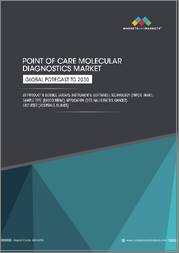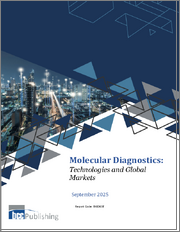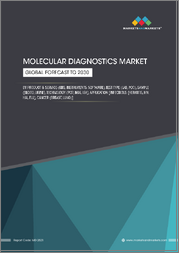
|
시장보고서
상품코드
1660669
종양 분자진단 시장 보고서 : 암 유형, 제품, 기술, 최종 사용자, 지역별(2025-2033년)Oncology Molecular Diagnostics Market Report by Cancer Type, Product, Technology, End-User, and Region 2025-2033 |
||||||
세계의 종양 분자진단 시장 규모는 2024년 48억 달러에 달했습니다. 향후 IMARC 그룹은 시장이 2033년까지 143억 달러에 이르며, 2025년과 2033년 사이에 12.37%의 성장률(CAGR)을 나타낼 것으로 예측했습니다. 암 유병률 상승, 분자진단 기술의 지속적인 진보, 정밀의료 채용 확대가 주로 시장 성장을 견인하고 있습니다.
종양 분자진단은 암세포의 생물학적 분자를 분석함으로써 암세포의 존재를 확인합니다. DNA, RNA 및 세포 단백질에서 특정 유전자 서열을 검출하고 측정하기 위해 혈액, 타액 및 종양 조직 샘플에 대해 몇 가지 검사가 수행됩니다. 종양 분자진단은 신속한 분석에 도움이 되고, 암의 맞춤형 치료에 활용되는 상세한 정보를 제공합니다. 이러한 진단 솔루션은 암의 조기 발견을 위한 임상 검사 및 포인트 오브 케어(POC) 검사에 응용되고 있습니다. 또한 혈액 은행은 제공된 혈액 샘플에 존재하는 병원체와 감염을 확인하는 데에도 사용됩니다.
라이프 스타일 변화, 노인 인구 증가, 흡연 증가 추세로 인한 암 유병률 증가는 세계 종양 분자진단 시장의 성장을 가속하는 주요 요인 중 하나입니다. 이와는 별도로 차세대 시퀀싱(NGS) 기술의 진보와 함께 신속하고 정확한 진단에 대한 수요 증가가 시장 성장에 기여하고 있습니다. 또한 바이러스 및 박테리아 감염을 앓고 있는 환자 수 증가와 헌혈 캠페인 참여 증가가 세계 종양 분자진단 약물 수요에 긍정적인 영향을 미치고 있습니다. 그러나 코로나바이러스 감염(COVID-19)의 갑작스런 유행에 의해 일부 의료기관은 진찰 횟수를 줄임으로써, 암 환자에게의 유행 위험을 경감하는 조치를 강구하고 있습니다. 또한 COVID-19 검사를 위해 진단 자원을 재사용하고 그 결과 종양학적 검사가 감소했기 때문에 암 환자의 정기 검진이 감소하고 있습니다.
이 보고서에서 다루는 주요 질문
- 세계의 종양 분자진단 시장은 지금까지 어떻게 추이하고 향후 어떻게 추이할 것인가?
- COVID-19가 세계의 종양 분자진단 시장에 미친 영향은?
- 주요 지역 시장은?
- 암 유형별 시장 분석은?
- 제품별 시장 분석은?
- 기술별 시장 분석은?
- 최종 사용자별 시장 분석은?
- 업계의 밸류체인의 다양한 단계란?
- 업계의 주요 성장 촉진요인과 도전은 무엇인가?
- 세계 종양 분자진단 시장의 구조와 주요 기업은?
- 업계 경쟁도는?
목차
제1장 서문
제2장 조사 범위와 조사 방법
- 조사의 목적
- 이해관계자
- 데이터 소스
- 1차 정보
- 2차 정보
- 시장 추정
- 상향식 접근
- 하향식 접근
- 조사 방법
제3장 주요 요약
제4장 소개
- 개요
- 주요 업계 동향
제5장 세계의 종양 분자진단 시장
- 시장 개요
- 시장 실적
- COVID-19의 영향
- 시장 예측
제6장 시장 분석 : 암 유형별
- 유방암
- 시장 동향
- 시장 예측
- 전립선암
- 시장 동향
- 시장 예측
- 대장암
- 시장 동향
- 시장 예측
- 자궁경부암
- 시장 동향
- 시장 예측
- 간암
- 시장 동향
- 시장 예측
- 폐암
- 시장 동향
- 시장 예측
- 혈액암
- 시장 동향
- 시장 예측
- 기타
- 시장 동향
- 시장 예측
제7장 시장 분석 : 제품별
- 기기
- 시장 동향
- 시장 예측
- 시약
- 시장 동향
- 시장 예측
- 기타
- 시장 동향
- 시장 예측
제8장 시장 분석 : 기술별
- 중합효소 연쇄반응(PCR)
- 시장 동향
- 시장 예측
- In Situ Hybridization
- 시장 동향
- 시장 예측
- 칩과 마이크로어레이
- 시장 동향
- 시장 예측
- 등온 핵산 증폭 기술(INAAT)
- 시장 동향
- 시장 예측
- 질량 분석
- 시장 동향
- 시장 예측
- DNA와 NGS 시퀀싱
- 시장 동향
- 시장 예측
- 전사 매개 증폭(TMA)
- 시장 동향
- 시장 예측
- 기타
- 시장 동향
- 시장 예측
제9장 시장 내역 : 최종 사용자별
- 병원 및 진료소
- 시장 동향
- 시장 예측
- 레퍼런스 연구실
- 시장 동향
- 시장 예측
- 기타
- 시장 동향
- 시장 예측
제10장 시장 내역 : 지역별
- 북미
- 미국
- 캐나다
- 아시아태평양
- 중국
- 일본
- 인도
- 한국
- 호주
- 인도네시아
- 기타
- 유럽
- 독일
- 프랑스
- 영국
- 이탈리아
- 스페인
- 러시아
- 기타
- 라틴아메리카
- 브라질
- 멕시코
- 기타
- 중동 및 아프리카
- 시장 동향
- 시장 분석 : 국가별
- 시장 예측
제11장 SWOT 분석
- 개요
- 강점
- 약점
- 기회
- 위협
제12장 밸류체인 분석
제13장 Porter's Five Forces 분석
- 개요
- 구매자의 협상력
- 공급기업의 협상력
- 경쟁도
- 신규 진입업자의 위협
- 대체품의 위협
제14장 가격 분석
제15장 경쟁 구도
- 시장 구조
- 주요 기업
- 주요 기업 프로파일
- Agilent Technologies, Inc.
- Abbott Laboratories
- Bayer AG
- Becton, Dickinson and Company
- Danaher Corporation
- F. Hoffmann-La Roche AG
- Hologic, Inc.
- Qiagen NV
- Siemens Healthcare
- Sysmex Corporation
The global oncology molecular diagnostics market size reached USD 4.8 Billion in 2024. Looking forward, IMARC Group expects the market to reach USD 14.3 Billion by 2033, exhibiting a growth rate (CAGR) of 12.37% during 2025-2033. The rising prevalence of cancer, ongoing advancements in molecular diagnostic technologies, and increased adoption of precision medicine are primarily driving the market's growth.
Oncology molecular diagnostics identify the presence of cancer cells by analyzing their biological molecules. Several tests are performed on the blood, saliva, and tumor tissue samples for detecting and measuring specific genetic sequences in the DNA, RNA, and cell proteins. Oncology molecular diagnostics help perform rapid analysis and provide detailed information that is further utilized in the personalized treatment of cancer. These diagnostics solutions find application in clinical and point-of-care (POC) testing for early detection of cancer. They are also used in blood banks to identify pathogens and infectious diseases present in the donated blood samples.
The rising prevalence of cancer on account of changing lifestyles, growing geriatric population, and the increasing trend of smoking represents one of the major factors impelling the global oncology molecular diagnostics market growth. Apart from this, the escalating demand for rapid and accurate diagnosis, along with advancements in next generation sequencing (NGS) techniques, is contributing to the growth of the market. Furthermore, a rise in the number of individuals suffering from viral and bacterial infections and the increasing participation in blood donation campaigns is positively influencing the demand for oncology molecular diagnostics worldwide. However, due to the sudden outbreak of the coronavirus disease (COVID-19), several healthcare institutions are undertaking steps to mitigate the risk of the pandemic on cancer patients by reducing the number of medical appointments. Moreover, regular screening for cancer patients has witnessed a decline due to the repurposing of diagnostics resources for providing COVID-19 testing and consequent reduction in oncology testing.
Key Market Segmentation:
Breakup by Cancer Type:
- Breast Cancer
- Prostate Cancer
- Colorectal Cancer
- Cervical Cancer
- Liver Cancer
- Lung Cancer
- Blood Cancer
- Others
Breakup by Product:
- Instruments
- Reagents
- Others
Breakup by Technology:
- Polymerase Chain Reaction (PCR)
- In Situ Hybridization
- Chips and Microarrays
- Isothermal Nucleic Acid Amplification Technology (INAAT)
- Mass Spectrometry
- DNA and NGS Sequencing
- Transcription Mediated Amplification (TMA)
- Others
Breakup by End-User:
- Hospitals and Clinics
- Reference Laboratories
- Others
Breakup by Region:
- North America
- United States
- Canada
- Asia Pacific
- China
- Japan
- India
- South Korea
- Australia
- Indonesia
- Others
- Europe
- Germany
- France
- United Kingdom
- Italy
- Spain
- Russia
- Others
- Latin America
- Brazil
- Mexico
- Others
- Middle East and Africa
Competitive Landscape:
The report has also analysed the competitive landscape of the market with some of the key players being Agilent Technologies, Inc., Abbott Laboratories, Bayer AG, Becton, Dickinson and Company, Danaher Corporation, F. Hoffmann-La Roche AG, Hologic, Inc., Qiagen N.V., Siemens Healthcare and Sysmex Corporation.
Key Questions Answered in This Report
- How has the global oncology molecular diagnostics market performed so far and how will it perform in the coming years?
- What has been the impact of COVID-19 on the global oncology molecular diagnostics market?
- What are the key regional markets?
- What is the breakup of the market based on the cancer type?
- What is the breakup of the market based on the product?
- What is the breakup of the market based on the technology?
- What is the breakup of the market based on the end-user?
- What are the various stages in the value chain of the industry?
- What are the key driving factors and challenges in the industry?
- What is the structure of the global oncology molecular diagnostics market and who are the key players?
- What is the degree of competition in the industry?
Table of Contents
1 Preface
2 Scope and Methodology
- 2.1 Objectives of the Study
- 2.2 Stakeholders
- 2.3 Data Sources
- 2.3.1 Primary Sources
- 2.3.2 Secondary Sources
- 2.4 Market Estimation
- 2.4.1 Bottom-Up Approach
- 2.4.2 Top-Down Approach
- 2.5 Forecasting Methodology
3 Executive Summary
4 Introduction
- 4.1 Overview
- 4.2 Key Industry Trends
5 Global Oncology Molecular Diagnostics Market
- 5.1 Market Overview
- 5.2 Market Performance
- 5.3 Impact of COVID-19
- 5.4 Market Forecast
6 Market Breakup by Cancer Type
- 6.1 Breast Cancer
- 6.1.1 Market Trends
- 6.1.2 Market Forecast
- 6.2 Prostate Cancer
- 6.2.1 Market Trends
- 6.2.2 Market Forecast
- 6.3 Colorectal Cancer
- 6.3.1 Market Trends
- 6.3.2 Market Forecast
- 6.4 Cervical Cancer
- 6.4.1 Market Trends
- 6.4.2 Market Forecast
- 6.5 Liver Cancer
- 6.5.1 Market Trends
- 6.5.2 Market Forecast
- 6.6 Lung Cancer
- 6.6.1 Market Trends
- 6.6.2 Market Forecast
- 6.7 Blood Cancer
- 6.7.1 Market Trends
- 6.7.2 Market Forecast
- 6.8 Others
- 6.8.1 Market Trends
- 6.8.2 Market Forecast
7 Market Breakup by Product
- 7.1 Instruments
- 7.1.1 Market Trends
- 7.1.2 Market Forecast
- 7.2 Reagents
- 7.2.1 Market Trends
- 7.2.2 Market Forecast
- 7.3 Others
- 7.3.1 Market Trends
- 7.3.2 Market Forecast
8 Market Breakup by Technology
- 8.1 Polymerase Chain Reaction (PCR)
- 8.1.1 Market Trends
- 8.1.2 Market Forecast
- 8.2 In Situ Hybridization
- 8.2.1 Market Trends
- 8.2.2 Market Forecast
- 8.3 Chips and Microarrays
- 8.3.1 Market Trends
- 8.3.2 Market Forecast
- 8.4 Isothermal Nucleic Acid Amplification Technology (INAAT)
- 8.4.1 Market Trends
- 8.4.2 Market Forecast
- 8.5 Mass Spectrometry
- 8.5.1 Market Trends
- 8.5.2 Market Forecast
- 8.6 DNA and NGS Sequencing
- 8.6.1 Market Trends
- 8.6.2 Market Forecast
- 8.7 Transcription Mediated Amplification (TMA)
- 8.7.1 Market Trends
- 8.7.2 Market Forecast
- 8.8 Others
- 8.8.1 Market Trends
- 8.8.2 Market Forecast
9 Market Breakup by End-User
- 9.1 Hospitals and Clinics
- 9.1.1 Market Trends
- 9.1.2 Market Forecast
- 9.2 Reference Laboratories
- 9.2.1 Market Trends
- 9.2.2 Market Forecast
- 9.3 Others
- 9.3.1 Market Trends
- 9.3.2 Market Forecast
10 Market Breakup by Region
- 10.1 North America
- 10.1.1 United States
- 10.1.1.1 Market Trends
- 10.1.1.2 Market Forecast
- 10.1.2 Canada
- 10.1.2.1 Market Trends
- 10.1.2.2 Market Forecast
- 10.1.1 United States
- 10.2 Asia Pacific
- 10.2.1 China
- 10.2.1.1 Market Trends
- 10.2.1.2 Market Forecast
- 10.2.2 Japan
- 10.2.2.1 Market Trends
- 10.2.2.2 Market Forecast
- 10.2.3 India
- 10.2.3.1 Market Trends
- 10.2.3.2 Market Forecast
- 10.2.4 South Korea
- 10.2.4.1 Market Trends
- 10.2.4.2 Market Forecast
- 10.2.5 Australia
- 10.2.5.1 Market Trends
- 10.2.5.2 Market Forecast
- 10.2.6 Indonesia
- 10.2.6.1 Market Trends
- 10.2.6.2 Market Forecast
- 10.2.7 Others
- 10.2.7.1 Market Trends
- 10.2.7.2 Market Forecast
- 10.2.1 China
- 10.3 Europe
- 10.3.1 Germany
- 10.3.1.1 Market Trends
- 10.3.1.2 Market Forecast
- 10.3.2 France
- 10.3.2.1 Market Trends
- 10.3.2.2 Market Forecast
- 10.3.3 United Kingdom
- 10.3.3.1 Market Trends
- 10.3.3.2 Market Forecast
- 10.3.4 Italy
- 10.3.4.1 Market Trends
- 10.3.4.2 Market Forecast
- 10.3.5 Spain
- 10.3.5.1 Market Trends
- 10.3.5.2 Market Forecast
- 10.3.6 Russia
- 10.3.6.1 Market Trends
- 10.3.6.2 Market Forecast
- 10.3.7 Others
- 10.3.7.1 Market Trends
- 10.3.7.2 Market Forecast
- 10.3.1 Germany
- 10.4 Latin America
- 10.4.1 Brazil
- 10.4.1.1 Market Trends
- 10.4.1.2 Market Forecast
- 10.4.2 Mexico
- 10.4.2.1 Market Trends
- 10.4.2.2 Market Forecast
- 10.4.3 Others
- 10.4.3.1 Market Trends
- 10.4.3.2 Market Forecast
- 10.4.1 Brazil
- 10.5 Middle East and Africa
- 10.5.1 Market Trends
- 10.5.2 Market Breakup by Country
- 10.5.3 Market Forecast
11 SWOT Analysis
- 11.1 Overview
- 11.2 Strengths
- 11.3 Weaknesses
- 11.4 Opportunities
- 11.5 Threats
12 Value Chain Analysis
13 Porters Five Forces Analysis
- 13.1 Overview
- 13.2 Bargaining Power of Buyers
- 13.3 Bargaining Power of Suppliers
- 13.4 Degree of Competition
- 13.5 Threat of New Entrants
- 13.6 Threat of Substitutes
14 Price Analysis
15 Competitive Landscape
- 15.1 Market Structure
- 15.2 Key Players
- 15.3 Profiles of Key Players
- 15.3.1 Agilent Technologies, Inc.
- 15.3.1.1 Company Overview
- 15.3.1.2 Product Portfolio
- 15.3.1.3 Financials
- 15.3.1.4 SWOT Analysis
- 15.3.2 Abbott Laboratories
- 15.3.2.1 Company Overview
- 15.3.2.2 Product Portfolio
- 15.3.2.3 Financials
- 15.3.2.4 SWOT Analysis
- 15.3.3 Bayer AG
- 15.3.3.1 Company Overview
- 15.3.3.2 Product Portfolio
- 15.3.3.3 Financials
- 15.3.3.4 SWOT Analysis
- 15.3.4 Becton, Dickinson and Company
- 15.3.4.1 Company Overview
- 15.3.4.2 Product Portfolio
- 15.3.4.3 Financials
- 15.3.4.4 SWOT Analysis
- 15.3.5 Danaher Corporation
- 15.3.5.1 Company Overview
- 15.3.5.2 Product Portfolio
- 15.3.5.3 SWOT Analysis
- 15.3.6 F. Hoffmann-La Roche AG
- 15.3.6.1 Company Overview
- 15.3.6.2 Product Portfolio
- 15.3.6.3 SWOT Analysis
- 15.3.7 Hologic, Inc.
- 15.3.7.1 Company Overview
- 15.3.7.2 Product Portfolio
- 15.3.7.3 Financials
- 15.3.7.4 SWOT Analysis
- 15.3.8 Qiagen N.V.
- 15.3.8.1 Company Overview
- 15.3.8.2 Product Portfolio
- 15.3.8.3 Financials
- 15.3.8.4 SWOT Analysis
- 15.3.9 Siemens Healthcare
- 15.3.9.1 Company Overview
- 15.3.9.2 Product Portfolio
- 15.3.9.3 Financials
- 15.3.9.4 SWOT Analysis
- 15.3.10 Sysmex Corporation
- 15.3.10.1 Company Overview
- 15.3.10.2 Product Portfolio
- 15.3.10.3 Financials
- 15.3.10.4 SWOT Analysis
- 15.3.1 Agilent Technologies, Inc.



















